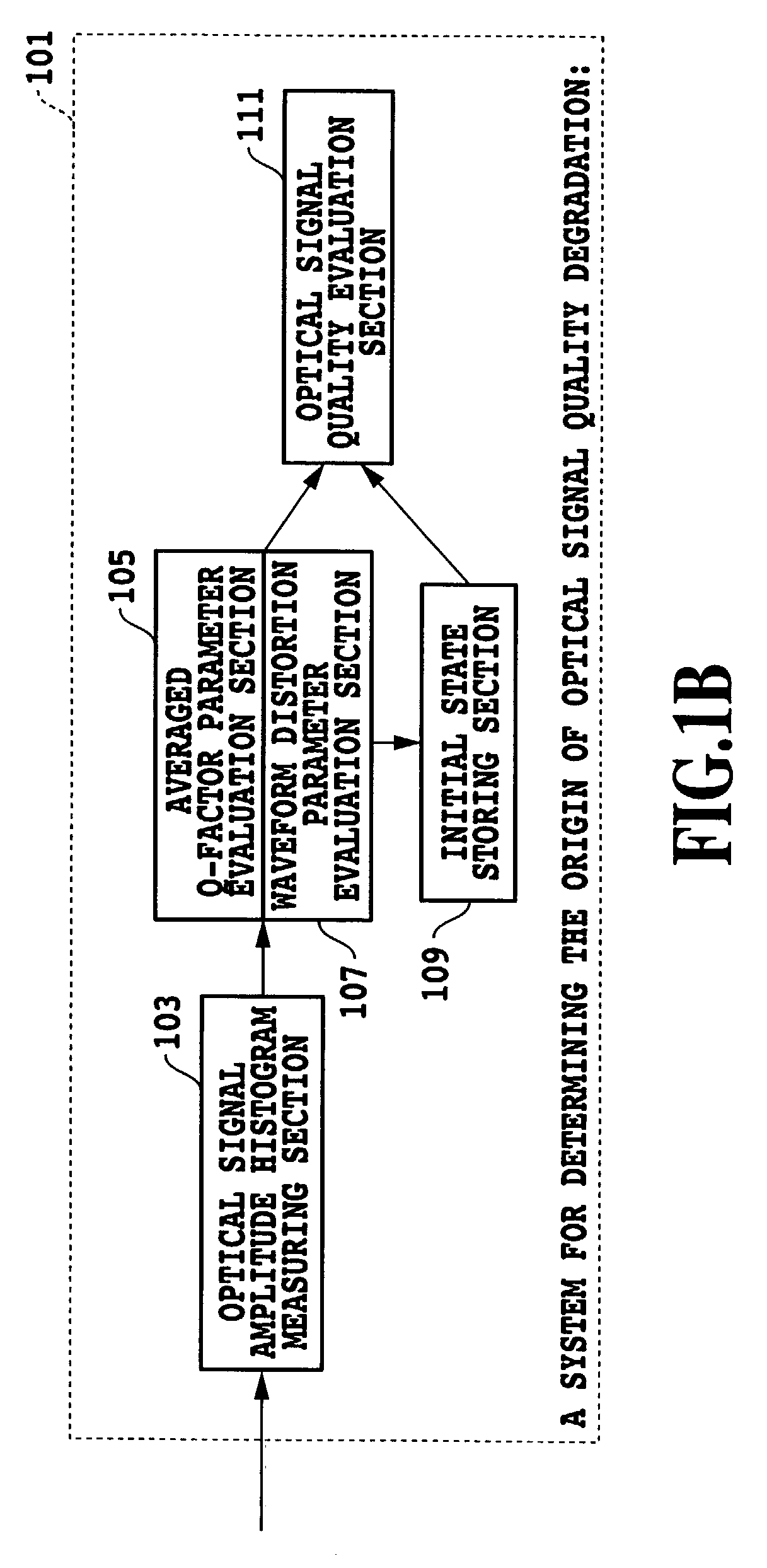Method and system for determining origin of optical signal quality degradation
a technology of optical signal quality and origin, applied in multiplex communication, transmission monitoring, instruments, etc., can solve the problems of insufficient single receiving system to handle a given bit rate, difficult application of inability to identify the section between optical amplifier repeater system at which the fault occurs, etc., to achieve high reliability, low cost, and large communication capability
- Summary
- Abstract
- Description
- Claims
- Application Information
AI Technical Summary
Benefits of technology
Problems solved by technology
Method used
Image
Examples
first embodiment
(First Embodiment)
[0046]FIGS. 1A and 1B show a system for determining the origin of optical signal quality degradation of a first embodiment in accordance with the present invention. The system for determining the origin of optical signal quality degradation 101 of the present embodiment comprises an optical signal amplitude histogram measuring section 103, an averaged Q-factor parameter evaluation section 105, a waveform distortion parameter evaluation section 107, an initial state storing section 109 and an optical signal quality evaluation section 111.
[0047]The optical signal amplitude histogram measuring section 103 obtains an optical amplitude histogram from the optical signal under measurement. The averaged Q-factor parameter evaluation section 105 obtains the averaged Q-factor parameter which is the optical signal quality parameter, from the optical signal amplitude histogram. The waveform distortion parameter evaluation section 107 obtains the waveform distortion parameter w...
second embodiment
(Second Embodiment)
[0098]FIGS. 12A and 12B show a system for determining the origin of optical signal quality degradation of a second embodiment in accordance with the present invention. The system for determining the origin of optical signal quality degradation 1201 of the present embodiment comprises an optical splitter 1203, an optical signal amplitude histogram measuring section 1205, an optical signal to optical noise power measuring section 1207, an averaged Q-factor parameter evaluation section 1209, an optical signal-to-noise ratio parameter evaluation section 1211, an initial state storing section 1213, and an optical signal quality evaluation section 1214.
[0099]The optical splitter 1203 splits the optical signal under measurement. The optical signal amplitude histogram measuring section 1205 obtains the optical signal amplitude histogram from a first optical signal under measurement after the splitting. The optical signal to optical noise power measuring section 1207 measu...
third embodiment
(Third Embodiment)
[0114]FIGS. 15A and 15B show a system for determining the origin of optical signal quality degradation of a third embodiment in accordance with the present invention. In FIGS. 15A and 15B, the same reference numerals designate the same or like portions to those of FIGS. 12A and 12B. The system for determining the origin of optical signal quality degradation 1501 of the present embodiment comprises an optical splitter 1203, an optical signal amplitude histogram measuring section 1205, an optical signal to optical noise power measuring section 1207, an averaged Q-factor parameter evaluation section 1503, a waveform distortion parameter evaluation section 1505, an optical signal-to-noise ratio parameter evaluation section 1211, an initial state storing section 1213, and an optical signal quality evaluation section 1214.
[0115]The optical splitter 1203 splits the optical signal under measurement. The optical signal amplitude histogram measuring section 1205 obtains the ...
PUM
 Login to View More
Login to View More Abstract
Description
Claims
Application Information
 Login to View More
Login to View More - R&D
- Intellectual Property
- Life Sciences
- Materials
- Tech Scout
- Unparalleled Data Quality
- Higher Quality Content
- 60% Fewer Hallucinations
Browse by: Latest US Patents, China's latest patents, Technical Efficacy Thesaurus, Application Domain, Technology Topic, Popular Technical Reports.
© 2025 PatSnap. All rights reserved.Legal|Privacy policy|Modern Slavery Act Transparency Statement|Sitemap|About US| Contact US: help@patsnap.com



